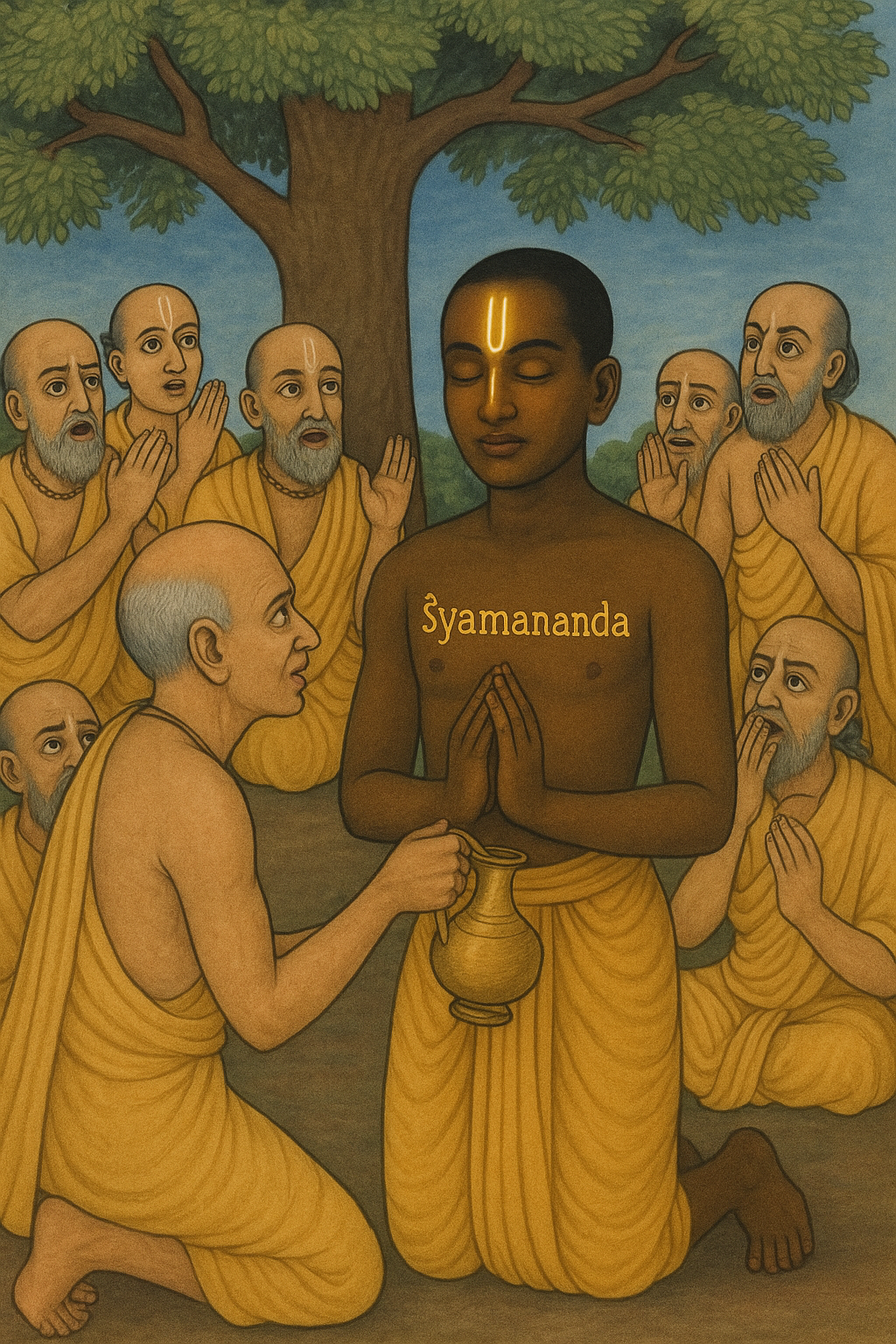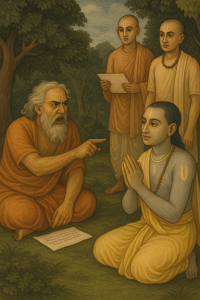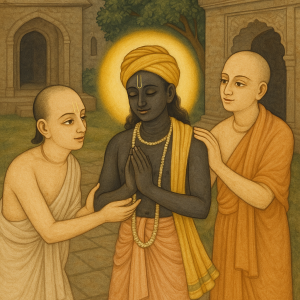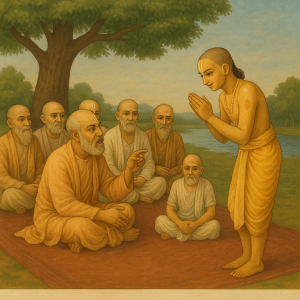(From Śyāmānanda Prakāśa – Chapter 3)
A Day of Divine Proof
After the two days granted for meditation, Śyāmānanda returned to the sacred grove where the assembly of mahāntas had gathered. They were seated under the kalpa-vṛkṣa at Rāsa-sthalī, the very spot where Śrī Rādhā and Kṛṣṇa dance in eternal līlā. Śyāmānanda approached with full humility—his heart steady, his voice clear, his eyes shining with faith.
He bowed to his guru, Hrdayānanda Gosvāmī, and to all the Vaiṣṇava elders and said:
“Today, in your presence, I shall accept your test. If I am truly a servant of my guru, and if this name and tilak are sanctioned by Śrī Rādhā Herself, then the truth will manifest.”
Hrdayānanda looked on with mixed emotions—part pride, part doubt, and part awe.
The Public Challenge: A Ritual of Testing
In solemn silence, Śyāmānanda stood in the midst of the gathered saints.
- His tilak, a bright golden mark bearing the impression of Śrī Rādhā’s foot, gleamed on his forehead.
- The name “Śyāmānanda” glowed with divine clarity across his chest.
Hrdayānanda stepped forward, as requested by the mahāntas, with a water pot in his hand.
“Let us see,” he announced, “if what appears to be miraculous is indeed eternal.”
With trembling hands, he washed Śyāmānanda’s forehead. The tilak vanished. Then he washed the chest. The name disappeared.
The assembly fell into a hush—heavy with divine anticipation.
The Silent Cry to the Divine
Śyāmānanda closed his eyes. He offered no argument. He made no speech. He simply called out, inwardly:
“O Śrī Rādhike! O Lalitā-devī! O Suvala! If this name and tilak are Yours, if I am truly Your servant, then please show the world the truth of my heart.”
Then, like a flash of lightning cutting through dark clouds, it happened.
The Miracle Manifested
Before the astonished gaze of all present:
- The tilak reappeared, brighter than before—two divine lines with a central dot, glowing as if painted by the fingertip of eternity.
- The name “Śyāmānanda” re-emerged across his chest—shimmering like golden script written by a celestial scribe.
A collective gasp swept through the assembly. Some cried out, “Jaya Rādhe!” Others fell to their knees. Tears flowed from eyes that had seen something beyond argument—beyond philosophy—beyond the reach of ritual.
The Lord had spoken—not with words, but with miraculous confirmation.
A Guru’s Heart Melts
Hrdayānanda, who had held so much pain and doubt in his heart, now trembled. His head fell. His pride shattered. He embraced his disciple and wept.
“You are not just my servant,” he cried. “You are my life. You are the proof of my guru’s mercy. You are the ornament of our sampradāya.”
He took Śyāmānanda upon his lap, kissed his forehead again and again, and said:
“Forgive me, my child. I could not see your glory. I tried to test the one who had already been accepted by Rādhā Herself.”
Celebration Among the Saints
The mahāntas cheered and shouted the name of Hari. Some danced, some wept, others embraced Śyāmānanda. The grove echoed with kīrtana, and even the trees seemed to sway in joy.
One Vaiṣṇava proclaimed:
“For the first time, a dream has become visible truth in waking life!”
Another said:
“This is not the doing of Śyāmānanda alone. It is the hand of Suvala, Lalitā, and Śrī Rādhā who now write their will upon his body.”
Still another whispered:
“He has pleased Śyāmā Herself. That is why he is called Śyāmānanda—one who gives joy to Rādhā.”
Reflections and Lessons
- Spiritual reality is self-evident—it reveals itself: Śyāmānanda did not have to convince anyone with logic. The truth manifested through divine action.
- Bhakti is beyond institutional boundaries: Though systems, rules, and traditions are sacred, they can never limit the grace of Rādhā-Kṛṣṇa. When They choose to bestow mercy, it overrides all worldly considerations.
- The mark of a true disciple is patience under suspicion: Śyāmānanda endured public testing with humility and without bitterness. This is the true dignity of a devotee.
- The tilak is not clay—it is the sign of eternal service: Śyāmānanda’s tilak was not merely a symbol; it was a declaration of identity in the spiritual world, affirmed by Rādhā Herself.
- True gurus are humble enough to learn from their disciples: Hrdayānanda’s transformation from skepticism to surrender teaches us that even great ācāryas must remain open to divine mystery.



